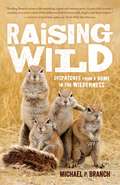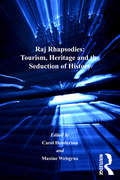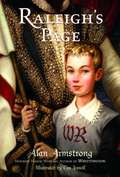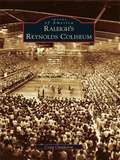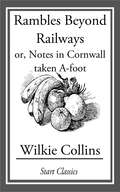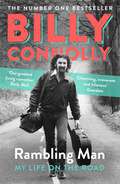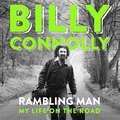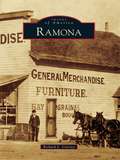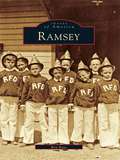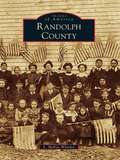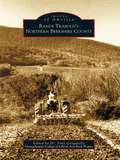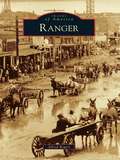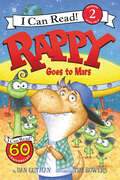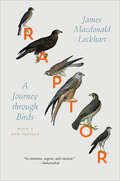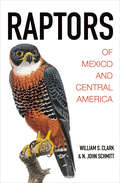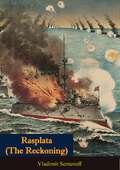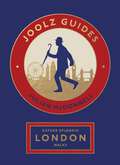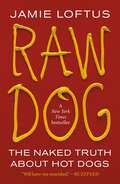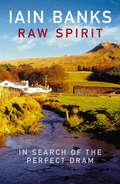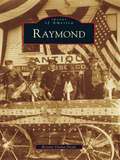- Table View
- List View
Rainy Day Paris: A Practical Guide: 100 Places to Keep Dry
by Wendy LynCosy cafés, vibrant restaurants, world-class galleries and everything in between – Paris is full of incredible things to do, whatever the weather. From iconic institutions to local, under-the-radar spots, Rainy Day Paris is the essential guide to 100 of the best things to do in the city when it’s raining (which is a lot of the time). Whether you’re looking for delicious places to eat, inspiring museums to mooch around or bars serving up creative cocktails, this handy book has it covered.
Raising Wild
by Michael P. Branch"Combining natural history, humor, and personal narrative, Raising Wild is an intimate exploration of Nevada's Great Basin Desert, the wild and extreme land of high desert caliche and juniper, of pronghorn antelope and mountain lions, where wildfires and snowstorms threaten in equal measure. Within this remote, high desert landscape sits the home of Michael Branch, where he, his wife, and their two curious little girls brazenly live among the packrats and ground squirrels, rattlesnakes and scorpions. In Branch's hands, this exceedingly barren and stark landscape becomes a place teeming with energy, surprise, and an endless web of connections that ultimately includes his family and home. It is in this desert setting where, in building a ladder to the stars, one can find a connection to the past and to the heavens; where his children's first garden becomes not the quaint blossoming of seed to flower and fruit but a smoke bomb-drenched exhibit of futility in the face of the inhospitable desert environment; where the surprise of fire acts as a reminder all too real of the unknowable that awaits us and for which we can never fully prepare. In this exhilarating, lyrical, and humorous exploration of natural history, Branch reveals a desert wilderness in which our ideas about nature and ourselves are challenged and transformed. "
Raj Rhapsodies: Tourism Heritage And The Seduction Of History (New Directions in Tourism Analysis)
by Carol E. Henderson Maxine WeisgrauHeritage is a prized cultural commodity in the marketing of tourism destinations. Particular aspects of heritage are often more actively promoted, with others played down. The representation of heritage in tourism as static and timeless, derived since time immemorial from a distant past, is seductive. In Asia, a major part of the tourism market lies in the sale and consumption of highly orientalized images and versions of culture and history. In India’s marketing discourse, the state of Rajasthan symbolizes the nation in its heritage-laden, traditional and most authentic form. These images draw heavily on the British period in India - the Raj. In one sense, this vision of Rajasthan is ennobling, highlighting moments of cultural pride. In another sense, it demeans, by omitting and obscuring salient features of contemporary life. This fascinating book explores the cultural politics of tourism through interdisciplinary perspectives. Carol E. Henderson and Maxine Weisgrau demonstrate that tourism heritage privileges elite histories that recapitulate colonial relationships, compelling non-elites to collude in these narratives of subordination even as they advance their own alternative visions of history.
Raleigh's Page
by Alan ArmstrongAndrew has grown up near the Plymouth docks hearing the sailors talk about America. Knowing that Andrew's heart is set on going to the new world, his father sends him up to London to serve as page in the house of Walter Raleigh. In Queen Elizabeth's court, Raleigh's the strongest voice in favor of fighting with Spain for a position in the New World, and everyone knows that it's just a matter of time before Her Majesty agrees to an expedition. Can Andrew prove himself fit to go on an expedition to the New World? Meticulously researched and brilliantly crafted, combining fictional characters with historical, Andrew's tale offers up a vivid look at the cloak-and-dagger politics of the time and a genuine feel for what it must have been like for the first Europeans to set foot on the beautiful, bountiful, savage shores of America.
Raleigh's Reynolds Coliseum (Images of America)
by Craig ChappelowFor more than half a century, William Neal Reynolds Coliseum was at the forefront of college basketball. When filled to capacity, 12,000 fans joined together to create the noise and heat that defined game night. Indeed, Reynolds Coliseum brought big-time basketball to the South. Most area residents know Reynolds as home to the popular Dixie Classic basketball tournament and the North Carolina State University's Wolfpack championship sports teams. Surprisingly, this building was not constructed specifically for basketball. Like the state of North Carolina, the coliseum's origins grew from agriculture, and it was significantly shaped by the impact of World War II. As home to the long-standing Friends of the College series, the coliseum helped extend cultural events to the general public by promoting "seven shows for seven dollars." It has hosted presidents and protesters, circuses and symphonies, tractor demonstrations and rock concerts. And yes, for one ten-year stretch, more people watched college basketball games in Reynolds Coliseum than in any other campus arena in America. This volume captures more than 50 years of North Carolina history from the best seat in the house, highlighting the people and events that shaped the building as much as any architect's pencil.
Rambles Beyond Railways; or, Notes in Cornwall taken A-foot
by Wilkie CollinsWilliam Wilkie Collins (1824-1889) was an English novelist, playwright, and writer of short stories. He was hugely popular in his time, and wrote 27 novels, more than 50 short stories, at least 15 plays, and over 100 pieces of non-fiction work. His best-known works are The Woman in White (1860), The Moonstone (1868), Armadale (1866) and No Name (1862). His works were classified at the time as 'sensation novels', a genre seen nowadays as the precursor to detective fiction and suspense fiction. He also wrote penetratingly on the plight of women and on the social and domestic issues of his time. His novel, No Name combined social commentary - the absurdity of the law as it applied to children of unmarried parents - with a densely-plotted revenge thriller. Amongst his other works are: Basil (1852), Hide and Seek (1854), After the Dark (1856), The Frozen Deep (1857), The Queen of Hearts (1859), Man and Wife (1870), The New Magdalen (1873), The Law and the Lady (1875), The Two Destinies (1876) and A Rogue's Life (1879).
Rambling Man: My Life on the Road
by Billy ConnollyPre-order the hilarious new book from the nation's favourite comedian, Billy ConnollyBeing a Rambling Man was what I always wanted to be, to live the way I damn well pleased. I've met the weirdest and most wonderful people who walk the Earth, seen the most bizarre and the most fantastic sights - and I've rarely come across something I couldn't get a laugh at. I don't think I've ever had a bad trip. Well, apart from in the 1970s, but that's a whole other story . . . When Billy set out from Glasgow as a young man he never looked back. He played his banjo on boats and trains, under trees, and on top of famous monuments. He danced naked in snow, wind and fire. He slept in bus stations, under bridges and on strangers' floors. He travelled by foot, bike, ship, plane, sleigh - even piggy-backed - to get to his next destination. Billy has wandered to every corner of the earth and believes that being a Rambling Man is about more than just travelling - it's a state of mind. Rambling Men and Women are free spirits who live on their wits, are interested in people and endlessly curious about the world. They love to play music, make art or tell stories along the way but, above all, they have a longing in their heart for the open road.In his joyful new book, Billy explores this philosophy and how it has shaped him, and he shares hilarious new stories from his lifetime on the road. From riding his trike down America's famous Route 66, building an igloo on an iceberg in the Arctic, playing elephant polo (badly) in Nepal and crashing his motorbike (more than once), to eating witchetty grubs in Australia, being serenaded by a penguin in New Zealand, and swapping secrets in a traditional Sweat Lodge ritual in Canada, Rambling Man is a truly global adventure with the greatest possible travel companion.
Rambling Man: My Life on the Road
by Billy ConnollyPre-order the hilarious new book from the nation's favourite comedian, Billy ConnollyBeing a Rambling Man was what I always wanted to be, to live the way I damn well pleased. I've met the weirdest and most wonderful people who walk the Earth, seen the most bizarre and the most fantastic sights - and I've rarely come across something I couldn't get a laugh at. I don't think I've ever had a bad trip. Well, apart from in the 1970s, but that's a whole other story . . . When Billy set out from Glasgow as a young man he never looked back. He played his banjo on boats and trains, under trees, and on top of famous monuments. He danced naked in snow, wind and fire. He slept in bus stations, under bridges and on strangers' floors. He travelled by foot, bike, ship, plane, sleigh - even piggy-backed - to get to his next destination. Billy has wandered to every corner of the earth and believes that being a Rambling Man is about more than just travelling - it's a state of mind. Rambling Men and Women are free spirits who live on their wits, are interested in people and endlessly curious about the world. They love to play music, make art or tell stories along the way but, above all, they have a longing in their heart for the open road.In his joyful new book, Billy explores this philosophy and how it has shaped him, and he shares hilarious new stories from his lifetime on the road. From riding his trike down America's famous Route 66, building an igloo on an iceberg in the Arctic, playing elephant polo (badly) in Nepal and crashing his motorbike (more than once), to eating witchetty grubs in Australia, being serenaded by a penguin in New Zealand, and swapping secrets in a traditional Sweat Lodge ritual in Canada, Rambling Man is a truly global adventure with the greatest possible travel companion.
Rambling Man: My Life on the Road
by Billy ConnollyThe hilarious new book from the nation's favourite comedian, Billy Connolly.A book of global adventures with Billy Connolly - an unconventional travel memoir that crisscrosses the world, encapsulating a lifetime of incredible journeys and hundreds of fascinating encounters.Being a Rambling Man was what I always wanted to be, to live the way I damn well pleased. I've met the weirdest and most wonderful people who walk the Earth, seen the most bizarre and the most fantastic sights - and I've rarely come across something I couldn't get a laugh at. I don't think I've ever had a bad trip. Well, apart from in the 1970s, but that's a whole other story . . . When Billy set out from Glasgow as a young man he never looked back. He played his banjo on boats and trains, under trees, and on top of famous monuments. He danced naked in snow, wind and fire. He slept in bus stations, under bridges and on strangers' floors. He travelled by foot, bike, ship, plane, sleigh - even piggy-backed - to get to his next destination. Billy has wandered to every corner of the earth and believes that being a Rambling Man is about more than just travelling - it's a state of mind. Rambling Men and Women are free spirits who live on their wits, are interested in people and endlessly curious about the world. They love to play music, make art or tell stories along the way but, above all, they have a longing in their heart for the open road.In his joyful new book, Billy explores this philosophy and how it has shaped him, and he shares hilarious new stories from his lifetime on the road. From riding his trike down America's famous Route 66, building an igloo on an iceberg in the Arctic, playing elephant polo (badly) in Nepal and crashing his motorbike (more than once), to eating witchetty grubs in Australia, being serenaded by a penguin in New Zealand, and swapping secrets in a traditional Sweat Lodge ritual in Canada, Rambling Man is a truly global adventure with the greatest possible travel companion.(P)2023 Hodder & Stoughton Limited
Ramona
by Richard L. CarricoOriginally founded as Nuevo, the community of Ramona is now known affectionately as the Valley of the Sun and was for decades labeled the "Turkey Capital of the World." Long before Spanish missionaries trekked across the verdant valley, 'Ipaay and Kumeyaay Indians called the area home. The temperate climate, fertile valleys, and easy access to both the ocean and to the mountains have made Ramona an ideal place to live for thousands of years. From the Mexican era of land grants to today, Ramona has always been associated with ranching, rodeos, and rural life. Today, nestled in the hills above San Diego, Ramona is a unique blend of rural and urban life.
Ramsey
by Ron KaseIn 1848, farmer Peter Ramsey sold part of his land to the Paterson and Ramapo Railroad for a right-of-way and a station. The Ramsey family had been local landholders since the 1740s, and the railroad timetables called the stop Ramsey's Station. A town developed around the station, and Main Street, which bisected the railroad tracks, became a bustling hub of commerce that supported a growing population. Hotels, general and specialty stores, blacksmithshops, and other businesses offered goods and services to the residents of this center of rural life. Ramsey's Station became the shipping point for strawberries grown throughout the area, making it the nation's strawberry capital until the late 1800s. The fields are gone, but photographs and stories of that era are included in Ramsey, many published here for the first time. Discover Ramsey's past and the pride felt by generations who have called Ramsey their home.
Rancho Mirage
by Leo A. MalletteRancho Mirage is a beautiful residential and desert-resort community nestled along the Santa Rosa Mountains, located between the cities of Palm Springs and Palm Desert in the Coachella Valley. Bighorn sheep and the Agua Caliente tribe of Cahuilla Indians were the area's early inhabitants. Date farms and ranchos developed after aquifers were discovered. Guest ranches soon followed and became favorite destinations for the rich and famous in the 1940s and 1950s. By the early 1950s, residential communities designed in classic Desert Modern style were being constructed along with the valley's first two country clubs with 18-hole golf courses. Rancho Mirage soon emerged as the "golf capital of the world" and has since grown to be a premier resort and residential community with a permanent population of 16,870 and several thousand additional winter residents who enjoy the city's 10 country clubs, three world-class resorts, and scores of restaurants.
Randolph County
by L. Mckay WhatleyThe geographic heart of North Carolina, Randolph County has been at the crossroads of history since the 17th century, when explorers first arrived along the Great Indian Trading Path. Every variety of religion, creed, and color could be found in the county from its creation in 1779, with combinations that often proved volatile. From the Uwharrie Mountains in the west to the Deep River Valley on the east, Randolph County has been home to powerful opposing forces. It is a county where potters are more common than doctors. It is home to five of North Carolina's first textile mills, yet it remains one of the state's leading agricultural producers. Its residents refused to secede from the Union but sent six companies into Confederate service. Although settled by pacifist Quakers, bitter guerrilla warfare pitted neighbor against neighbor in both the American Revolution and the Civil War. A dry county that permits no sales of alcoholic beverages, it fostered the racing spirit of NASCA R by running moonshine along its back roads. It is a county with a history, politics, and people of vision, depth, and complexity.
Randy Trabold's Northern Berkshire County
by Massachusetts College of Liberal Arts Book Project Dr Tony GengarellyRandy Trabold was the chief photographer for the North Adams Transcript from 1935 until he retired in 1979. Randy Trabold's Northern Berkshire County documents his formidable capacity to record the pulse of the northern Berkshire area-from tragedy to laughter and from the bizarre to the incredibly beautiful. While the book features familiar landmarks, such as North Adams, Williamstown, the Mohawk Trail, and Mount Greylock, it also takes a tour of the region's beautiful landscape, revisits the Fall Foliage Festival, and explores the frustrations and humor of Berkshire winters.
Ranger (Images of America)
by Alfred RogersRanger began in the 1870s near a Texas Ranger camp in northeastern Eastland County. It remained a farming community of about 700 people until October 17, 1917, when an oil well on the McCleskey farm, south of town, ushered in one of the best-known oil discoveries. Within months, Ranger's population had surged to approximately 30,000, including investors, speculators, wildcatters, oil field workers, curious onlookers, and the usual criminal element attracted to oil boomtowns. Crime became so rampant that the Texas Rangers eventually were called in to intercede. Oil production peaked in 1919 before tapering off. Images of America: Ranger covers a period of about 75 years from the town's beginnings to 1950.
Rantoul and Chanute Air Force Base (Images of America)
by Mark D. HansonRantoul and the former Chanute Air Force Base are inseparably intertwined as primary players in a single historical narrative. Rantoul was first founded as an agriculturally based community in 1848 near an area known as Mink Grove. The settlement boomed with the coming of the Illinois Central Railroad in 1854; a railroad championed by the town's namesake, Robert Rantoul Jr. Disaster followed in 1899 and again in 1901 with devastating fires. Then, in 1917, a U.S. Army flying field was built on the outskirts of Rantoul. Named after the aviation pioneer Octave Chanute, Chanute Field, later Chanute Air Force Base, became a premier technical training facility. A mutually beneficial relationship quickly developed between these civilian and military establishments that would last for over 75 years. Chanute Air Force Base closed in 1993, ushering in yet another new era for the village of Rantoul.
Rapporti a distanza
by Ben Jackson Arianna Giorgi Sam LawrenceQuesto libro è una guida completa ai rapporti a distanza. Se avete una relazione a distanza o state pensando di iniziarne una, allora questo libro fa per voi. RAPPORTI A DISTANZA contiene una quantità impressionante di informazioni, cose che avete sempre voluto sapere e molto probabilmente non avete nemmeno preso in considerazione. Scritto da una coppia che si è incontrata in rete e che ha un felice rapporto a distanza da anni! Dalle relazioni a distanza tradizionali, alle relazioni online, fino a quelle con personale militare, questo libro ha qualcosa per tutti. All'interno scoprirete informazioni su: La definizione di un rapporto a distanza; Comunicazione, Strumenti, trucchi e suggerimenti; Militari e lavoratori spesso in viaggio; Amici e famiglia; Un incontro da ricordare; Affrontare i problemi in un rapporto a distanza; Cose da fare mentre siete separati; Immigrazione e molto altro ancora! Non importa se la vostra relazione è appena iniziata o se dura da un po'. Fatevi un favore, acquistate questo libro! Considerate questo e-book un piccolo investimento per una felicità lunga tutta la vita.
Rappy Goes to Mars (I Can Read Level 2)
by Dan GutmanOne day at recess, Rappy the dinosaur gets taken by aliens on a U.F.O. ride. The head alien, Janet, wants Rappy to live with her—on Mars! Will Rappy stay in space to roam, or will he rap his way back home?Beginning readers will love rapping along as Rappy goes on an out-of-this-world adventure. This rhyming Level Two I Can Read is geared for kids who read on their own but still need a little help.
Raptor: A Journey through Birds
by James Macdonald LockhartFrom the merlin to the golden eagle, the goshawk to the honey buzzard, James Macdonald Lockhart’s stunning debut is a quest of beak, talon, wing, and sky. On its surface, Raptor is a journey across the British Isles in search of fifteen species of birds of prey, but as Lockhart seeks out these elusive predators, his quest becomes so much more: an incomparably elegant elegy on the beauty of the British landscape and, through the birds, a journey toward understanding an awesome power at the heart of the natural world—a power that is majestic and frightening in its strength, but also fragile. Taking as his guide the nineteenth-century Scottish naturalist and artist William MacGillivray, Lockhart loosely follows the historical trail forged by MacGillivray as he ventured from Aberdeen to London filling his pockets with plants and writing and illustrating the canonical A History of British Birds. Linking his journey to that of his muse, Lockhart shares his own encounters with raptors ranging from the scarce osprey to the successfully reintroduced red kite, a species once protected by medieval royal statute, revealing with poetic immediacy the extraordinary behaviors of these birds and the extreme environments they call home. Creatures both worshipped and reviled, raptors have a talon-hold on the human heart and imagination. With his book, Lockhart unravels these complicated ties in a work by turns reverent and euphoric—an interweaving of history, travel, and nature writing at its best. A hymn to wanderers, to the land and to the sky, and especially to the birds, Raptor soars.
Raptors of Mexico and Central America
by Lloyd Kiff N. John Schmitt William S. ClarkRaptors are among the most challenging birds to identify in the field due to their bewildering variability of plumage, flight silhouettes, and behavior. Raptors of Mexico and Central America is the first illustrated guide to the region's 69 species of raptors, including vagrants. It features 32 stunning color plates and 213 color photos, and a distribution map for each regularly occurring species. Detailed species accounts describe key identification features, age-related plumages, status and distribution, subspecies, molt, habitats, behaviors, potential confusion species, and more.Raptors of Mexico and Central America is the essential field guide to this difficult bird group and the ideal travel companion for anyone visiting this region of the world.Covers all 69 species of raptors found in Mexico and Central AmericaFeatures 32 color plates and hundreds of color photosProvides multiple illustrations of each speciesDepicts and describes variations in plumage by individual, morph, age, and regionDescribes behavior, food preferences, hunting strategies, vocalizations, and moltCovers rare and extralimital speciesIncludes distribution maps and flight silhouettes
Rasplata (The Reckoning) by Commander Vladimir Semenoff.: His Diary During The Blockade Of Port Arthur And The Voyage Of Admiral Rojestvensky's Fleet
by Vladimir SemenoffImmerse yourself in the dramatic and harrowing events of the Russo-Japanese War through the firsthand account of Commander Vladimir Semenoff in "Rasplata (The Reckoning)." This gripping diary offers an unparalleled glimpse into the life of a naval officer during one of the most significant conflicts of the early 20th century, capturing the intense emotions and strategic complexities of wartime.Commander Vladimir Semenoff, a distinguished officer of the Russian Imperial Navy, chronicles his experiences during the protracted siege of Port Arthur and the perilous voyage of Admiral Rojestvensky's fleet. His detailed and candid entries provide a vivid portrayal of the hardships faced by the sailors, the strategic maneuvers employed, and the personal sacrifices made during the conflict."Rasplata (The Reckoning)" is more than a military diary; it is a deeply human story of resilience, camaraderie, and the relentless pursuit of duty amidst overwhelming odds. Semenoff’s narrative brings to life the daily struggles and extraordinary events that defined the blockade of Port Arthur, offering insights into the tactical decisions and the relentless pressure faced by the fleet.Semenoff’s reflections on the epic voyage of Admiral Rojestvensky's fleet from the Baltic Sea to the Pacific Ocean highlight the logistical challenges and the morale of the crew as they navigated treacherous waters and prepared for battle. His account of the climactic Battle of Tsushima, a pivotal moment in naval history, provides a firsthand perspective on the strategies, heroism, and tragic outcomes of the engagement.This book is an essential read for military historians, naval enthusiasts, and anyone interested in the personal experiences of those who lived through the crucible of war. Semenoff’s meticulous documentation and evocative storytelling offer a rare and compelling window into a tumultuous period of history.Join Commander Vladimir Semenoff on his remarkable journey through the trials of war, and gain a deeper understanding of the complexities and human elements of naval warfare in "Rasplata (The Reckoning)." This powerful diary stands as a testament to the courage and determination of those who served in the face of adversity.
Rather Splendid London Walks: Joolz Guides' Quirky and Informative Walks Through the World's Greatest Capital City
by Julian McDonnellPip-pip and Tally-Ho... meet the most famous tour guide on YouTube, Joolz Guides! In Rather Splendid London Walks you can join Joolz himself on 20 fun-packed walks around the city, picking out the top sights, sounds and secret features that you wouldn’t spot without an expert guide on hand. On your journey you will learn about London's finest palaces, historic houses and murky drinking dens, visiting unscrupulous politicians, literary figures, scientific heroes, notorious criminals, and stars of the stage and screen along the way. Highlighting historical features and oddities en route, including stink pipes, cattle troughs and parish boundary markers, Joolz has more tales, facts and anecdotes than you've had hot dinners. From Pimlico to Peckham, Holland Park to Highgate, Southwark to Soho, Joolz Guides unveils the hidden gems and fantastic follies around every corner of the metropolis.
Raw Dog: The Naked Truth About Hot Dogs
by Jamie LoftusA NEW YORK TIMES AND INDIE BESTSELLER!Part travelogue, part culinary history, all capitalist critique—comedian Jamie Loftus's debut, Raw Dog, will take you on a cross-country road trip in the summer of 2021, and reveal what the creation, culture, and class influence of hot dogs says about America now.A Best Book of the Year from NPR and Vulture. Featured in: NPR Weekend Edition • Bon Appétit • Oprah Daily • Glamour • NY Mag • Splendid Table • The Wall Street Journal • Eater • Betches • USA Today • Boston Globe • Eater • Slate • The Next Big Idea Club • Buzzfeed and more “Wise and funny” —ANDY RICHTER • “Revealing, funny, sad, horny, and insatiably curious” —SARAH MARSHALL • “A wild ride” —ROBERT EVANS • “Deeply incisive and hilariously honest” —JACK O’BRIEN • “Gonzo yet vulnerable” —GABE DUNN • “Hot dog Moby-Dick” —BRANSON REESE • “One of the freshest and most insightful new comedic voices of this decade.” —LINDSAY ELLIS Hot dogs. Poor people created them. Rich people found a way to charge fifteen dollars for them. They’re high culture, they’re low culture, they’re sports food, they’re kids' food, they’re hangover food, and they’re deeply American, despite having no basis whatsoever in America's Indigenous traditions. You can love them, you can hate them, but you can’t avoid the great American hot dog.Raw Dog: The Naked Truth About Hot Dogs is part investigation into the cultural and culinary significance of hot dogs and part travelogue documenting a cross-country road trip researching them as they’re served today. From avocado and spice in the West to ass-shattering chili in the East to an entire salad on a slice of meat in Chicago, Loftus, her pets, and her ex eat their way across the country during the strange summer of 2021. It’s a brief window into the year between waves of a plague that the American government has the resources to temper, but not the interest.So grab a dog, lay out your picnic blanket, and dig into the delicious and inevitable product of centuries of violence, poverty, and ambition, now rolling around at your local 7-Eleven.The hardcover edition of Raw Dog: The Naked Truth About Hot Dogs includes gorgeous endpapers, an illustrated case, as well as illustrations by the author throughout."Raw Dog will leave you nourished." —BuzzFeed"You will certainly never read a funnier book about taking a hot dog-themed road trip across America." —Glamour"A journey both silly and profound." —Vulture, Best Books of 2023At the Publisher's request, this title is being sold without Digital Rights Management Software (DRM) applied.
Raw Spirit: In Search of the Perfect Dram
by Iain BanksA fascinating journey through Scotland's famous distilleries with legendary author Iain Banks No true Scotsman can resist the allure of the nation's whisky distilleries. In an absorbing voyage as interesting to non-drinkers as to true whisky connoisseurs, sci-fi and literary author Iain Banks explores the rich heritage of Scottish whisky, from the largest and most famous distilleries to the smallest, most obscure operations.Whisky is more than a drink: it's a culture, a binder that joins together people, places and products far across Scotland's rugged terrain. Switching from cars to ferries to bicycles, Banks crisscrosses his homeland, weaving an engrossing narrative from the strange people, fascinating traditions, and downright bizarre places he encounters on his journey down Scotland's great golden road.
Raymond (Images of America)
by Kristin Ozana DoyleThe winding Lamprey River snakes its way through many areas of Raymond and has played a dual role in the town's history, helping in times of fire and hindering in times of flood. Raymond began as a small farming village and grew over the years into abustling resort community. The town was a busy stop on the Boston and Maine Railroad line, and its accessibility aided the town in its expansion. Raymond has since evolved into a modern town witha strong sense of historical perspective. The vintage images in this book, culled from the collections of the Raymond Historical Society and numerous local residents, document the history of this constantly changing community.

